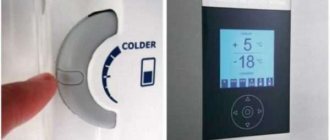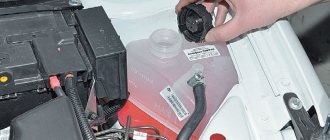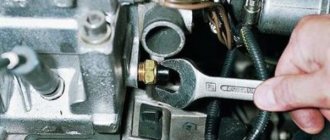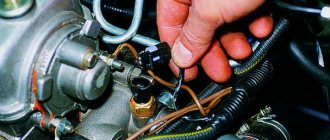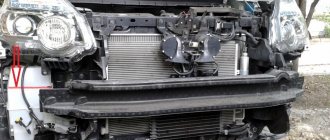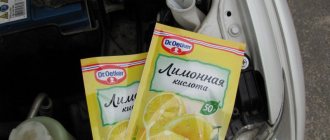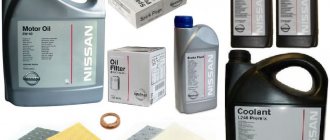The standard method of dealing with overheating of the Chevy Niva engine is to replace the coolant, or as it is also called, antifreeze or antifreeze. However, if the car is not new, and the antifreeze was previously changed irregularly, then a regular replacement may not work.
Over time, carbon deposits, rust and other deposits accumulate in the engine cooling system, clogging channels and hoses that need to be removed. Flushing the Chevrolet Niva engine cooling system is a simple but rather lengthy process. It makes sense to save on a car service and do it yourself.
A little about the problem
The expansion tank is an integral component of the internal combustion engine cooling system. The main task of this element is to dampen pressure fluctuations inside pipelines that arise as a result of a decrease or increase in the volume of cooling liquid when it is cooled and heated, respectively.
Such a capacity allows you to reduce mechanical loads on the entire cooling system. Thus, the internal combustion engine is protected from water hammer and air locks. Although they cannot be completely prevented, as a result, sometimes you have to figure out how to remove the airlock. Essentially, the tank replenishes the liquid deficit in the cooling lines and acts as a receiving tank when excess coolant appears, which occurs when the composition is heated. Structurally, it is a seemingly ordinary sealed plastic tank.
An integral element of the unit is the expansion tank cap, which also serves as a valve. With its help, pressure enters the tank from the outside when there is a deficiency in the system, or excess pressure is released.
When the coolant heats up, the liquid gradually expands, thereby filling the tank space. In parallel with the increase in evaporation from heating, the internal pressure increases.
Folk remedies for washing
These (if you can call it that) products are sold in almost every grocery or hardware store and they are very affordable.
LEMON ACID . Previously, this washing was the most popular of all. It effectively removes rust and dirt, and works especially well if the car was driven with regular water (and not with antifreeze). After all, acid removes rust elements well, but alkali is effective against scale.
But citric acid is not strong, and is often not used now. It's worth noting though.
Dilute it with warm water, about 50 grams (in case of severe contamination, up to 100 grams) per liter of distilled water (yes, this is exactly what you should take, it is clean without any impurities).
After you dilute the solution, drain the antifreeze or antifreeze that was poured into the system. Next, start the engine and warm up the system to operating temperature. Why do you need to leave it for 3-6 hours, you can do it overnight. Next, drain the dirty solution - AFTER THAT, WASH WITH PURE DISTILLED WATER and fill in new coolant.
ACETIC ACID . This is also an acid and is also easy to find (vinegar is sold in almost any store). Like citric acid, it perfectly flushes the system from rust. It is worth mixing in the following proportion: 200-250 grams of vinegar per 5 liter bottle of water (again, distilled).
We all work according to the same principle. We drain the old liquid, fill in our solution, and heat it to operating temperature. Next, let it run for 40–60 minutes, drain it, rinse it with clean water and pour in antifreeze.
BORIC ACID . Again effective against rust. We buy 10 packages of 5 grams, that is, in total we need about 50 grams. Take 5 liters of water (bottle) and stir. We drain everything from the cooling system and add what we stirred. We warm up the engine to operating temperature, then run it at idle for 30-40 minutes and drain it.
TRILON B. I already wrote about this tool here . It is loved by various numismatists and diggers, who scrub off not only rust, but also oxides. By the way, it can also be used in a battery, because it perfectly washes its sulfates from lead .
Sold in cans of 250 grams in powder. They can flush the system in two ways and they both work:
- Dilute 250 grams in 5 liters of water, pour into the radiator and let it “grind” for 30 minutes, then drain - rinse with water (distillate) - clean “coolant”
- Some add antifreeze directly to the old antifreeze, repeat the process (30 minutes at idle). Afterwards, be sure to rinse with water and fill with clean liquid.
Either way it works quite well.
COCA- COLA and FANTA . Despite the fact that these drinks are not intended for rinsing directly, they are still a “REFRESHING DRINK”. They do an excellent job of this task. However, I still advise you to use “COCA-COLA ZERO” or “LITE”. Why?
Look in FANTA, it contains citric acid, it removes rust, but does not fight scale so well.
Regular COCA-COLA contains citric and phosphoric acid. On the one hand, this is an ideal composition for washing. BUT, it contains A LOT OF SUGAR, which can seal the system (especially thin channels)
COCA-COLA ZERO. This is almost the same composition as regular cola, only it uses a sweetener. THIS IS WHAT WE NEED.
APPLICATION – very simple. To wash the entire system, you don’t just need to grind for 30 minutes at idle. You need to ride with this solution for about 100 - 150 km. Next, drain, rinse with water and fill with clean antifreeze or antifreeze. It works very well, tested more than once.
Now we are watching a short video.
Main reasons
There are several main reasons for the release of coolant through the expansion tank.
They are divided into several groups depending on what exactly the problems are associated with.
Similar phenomena occur on a variety of vehicles, including:
- VAZ 2114;
- Gazelle;
- KAMAZ;
- DAF;
- Lada Kalina;
- Nissan Almera;
- Mitsubishi Lancer;
- Hyundai Accent;
- Volkswagen Polo;
- Nissan Qashqai;
- Daewoo Lanos;
- Lada Granta;
- Mazda 6;
- Mercedes;
- Audi A5, etc.
The likelihood of encountering a similar problem is higher for cars with a higher mileage. Although we cannot rule out antifreeze emissions from cars that were only recently purchased and put into operation.
Let's look at the possible reasons separately.
Tank malfunctions
At first it may seem that the tank is designed extremely simply, and there simply cannot be any significant problems with it.
But it is because of the tank that the coolant most often begins to eject.
- The seal is broken. Antifreeze has a high fluidity, which is why it can penetrate even through small cracks that are not visually noticeable. Thus, when the pressure increases, the liquid is squeezed out. Check for stains under the car after parking. It is best to completely replace the tank if there is leakage;
- Defective threaded connections. When checking the expansion tank cap, pay attention to the threads of the neck and the valve itself. Cheap and low-quality products often have burrs and chips, which make a tight fit impossible. An increase in pressure provokes coolant leakage through these channels;
- Valve. The valve cover is also a common cause of fluid leaking from the reservoir. Moreover, the problem is quite easy to identify. Everything works fine at idle. But by increasing the speed, under load, the liquid is literally pushed out from under the valve. First try to disassemble and clean the element. If this does not help, the valve needs to be replaced.
But these are not the only possible reasons. Let's move on in search of the truth.
Coolant circulation is impaired
If circulation is disrupted, the fluid overheats greatly, pressure increases and coolant is squeezed out through the valve cover.
There are several reasons here.
- Thermostat is faulty. If it does not work, then the liquid will flow only in a small circle, bypassing the antifreeze cooling radiator. In this situation, the motor will overheat. It is necessary to check and, if necessary, change the unit;
- Air lock or clogged channels. Blockages appear due to scale, mechanical debris, improper mixing of antifreeze, etc. This is where the radiator is cleaned and flushed;
- Water pump failure. I have already talked about the signs and causes of a malfunctioning water pump in a separate article. Just follow the link.
The potential reasons don't end there. There is one more important point that is worth paying attention to.
Leak formation
Most often, motorists are faced with a shortage of coolant in the cooling system. When the volume of antifreeze drops, the temperature rises as the engine cools. Heating leads to active evaporation and an increase in pressure.
If, when the engine cools down, the level remains unchanged in the tank, then you need to look for a problem in the circulation. And when the level drops, then the seal is broken. That means there is a leak somewhere.
There are several main probable causes of leakage:
- The pipes and hoses of the system are worn out and aged. They will need to be replaced, strengthening the new parts with additional clamps to increase the reliability of the connections;
- Cracks in the heater cores and cooling system. If the problem is in the stove, then antifreeze will leak into the cabin. Usually at the front passenger's feet;
- Problems with the pump and thermostat seals. Look for traces of antifreeze near those elements that act as suspects;
- The cylinder head gasket is broken. In this case, the cylinder head gasket will need to be replaced. The danger is that the coolant can penetrate the engine cylinders or lubrication system, mixing with the oil. The consequences can be extremely disastrous for the engine, including jamming of the internal combustion engine.
Now you are clearly convinced that there is nothing good in throwing out antifreeze through the expansion tank. When the first signs appear, be sure to stop the car, start looking for the causes and eliminating them.
Tags: squeezes out coolant on ZMZ 402
Comments 43
Cylinder head gasket 100%. Change it before it's too late, otherwise you'll catch your coolant in the crankcase. You'll end up with oil... I've already had this happen twice... The coolant was rushing... To check, put a condom on the expansion tank. if it blows. So this is it!
The valve in the expansion cap does not work, there is no pressure in the system and that is why it overheats. try wrapping the lid through a plastic bag,
I removed the head like this 2 times... but it was a manufacturing defect in the casting of the sleeve, small holes at the very top with a diameter of 0.5 to 0.8
Why did you take out the thermostat?
I have a single pulley from ZMZ 513, only advantages
and the pump/vent pulleys can be installed from a gazelle/lawn - the speed of the fan and pump will be correspondingly higher. on the 402nd, the knee and pump pulleys are equal in diameter.
It was heating up for me, so I installed a radiator from a UAZ (it’s larger). stood up without sawing or welding the body through 2 corners with holes.
remove the hood to let the hot air escape
and drive without a hood all summer?
there was such a problem, but 406
It's a matter of heat balance. The engine produces more heat into the CO than the radiator can produce. I solved this problem by installing a SHAAZ Nokolok radiator. This is an aluminum radiator with soldered honeycombs and an output of 75 kW. The 402 engine simply doesn’t have that much extra heat. Costs 3500 rubles, light and less coolant. I bought it in Moscow time, but I think there is a dealer in Krasnodar. www.shaaz.biz/catalogue/12/pos/202 automir45.ru/radiator-vodyanoy-3110a-1301010 tdradiator.ru/catalogue/c…e87323fb12a2c35b83a40d293
Buy a fan for the pump from UMZ 4216 (Gazelle business) it has like 12 or 14 blades + electric fan
Buy a fan for the pump from UMZ 4216 (Gazelle business) it has like 12 or 14 blades + electric fan
11 blades and it blows normally. It works in Crimea.
Firstly, you cannot turn off the engine when it starts to boil or is already boiling; you expose the engine to thermal shock (the head may move). The engine should idle until it cools down, because you have no problems on straight sections. Secondly, return the thermostat to any temperature (on my 3110 from 402 it was set to 87 degrees), but be sure to work, you can check it at home in boiling water (roughly, even without a thermometer, so that it opens and closes completely). Without a thermostat, the main flow of coolant flows in a small circle (after all, the liquid is not stupid, go where there is more resistance, small radiator tubes), but where is it cooled? Thirdly, it is necessary to have a working plug in the expansion tank so that both valves work and maintain pressure, otherwise the boiling point decreases. Fourth, flush the radiator of the cooling system, both outside and inside. (Our cars are not young, and we are not the first owners; we don’t know what happened before us, what kind of car they drove). Fifthly, check the functionality of the pump (my impeller was slipping and throwing out antifreeze). Sixth, normal coolant (not leftist). Seventh, remove the air plug, with the expansion tank cap removed, in cycles of 30 seconds, let the engine run: idling, 1500 rpm, 3000 rpm for 3-5 minutes. And then look at the head gasket, although it’s unlikely to be necessary, since the antifreeze is clean and no gases go into the expansion tank...
A simple look at the problem.
The expansion tank plays an important role in the cooling system. Its main function is to dampen pressure fluctuations in pipelines that arise as a result of an increase (decrease) in the volume of antifreeze during heating (cooling). Thanks to the presence of such a container, mechanical loads on system elements are reduced, water hammer and the appearance of air locks are prevented.
In fact, the tank replenishes the lack of fluid in the lines during cooling and serves to receive excess fluid when heating. Structurally, it is made in the form of a plastic sealed container.
A mandatory part of the design is a safety valve for releasing excess pressure into the atmosphere.
When antifreeze heats up, it expands, filling the free space of the tank, and the evaporation rate increases. This leads to an increase in pressure in the volume. An increase in pressure above a threshold value triggers the built-in valve.
The only situation when antifreeze is thrown out of the expansion tank is when the valve fails to perform its assigned functions.
Causes of the phenomenon.
There are several groups of reasons why antifreeze is thrown out of the expansion tank.
Problems with the tank.
Despite the simplicity of the design of the expansion tank, it is often its malfunctions that cause problems with the release of antifreeze:
- Violation of tightness. Antifreezes are characterized by high fluidity rates; accordingly, even a microcrack in the walls of the vessel, indistinguishable to the naked eye, will lead to the squeezing out of the liquid, especially with increasing pressure. The main sign of a malfunction will be the appearance of a coolant stain under the car after a long period of parking. The best solution is to replace the tank. Do not forget that there is a significant amount of low-quality products on the market from little-known manufacturers offering thin-walled tanks made in violation of production technologies. A pre-installation check performed using a compressor will help you avoid problems in the future.
- Defective threaded connections. The tightness of the device largely depends on the quality of the threads on the neck and lid. Chips and burrs prevent the parts from fitting tightly. As a result, as the pressure increases, the coolant is knocked out through the formed microchannels. When replacing, you should pay attention to the quality of the neck and lid; a preliminary check is advisable.
- Valve fault. The lid valve is also a source of problems. A typical situation is that there are no problems at idle engine speed; as the speed increases and the load increases (while driving), the antifreeze literally knocks out from under the expansion tank cap. Disassembling the valve and then cleaning it often helps to resolve the problem. Otherwise, replacement is required (it is preferable to replace the entire cover).
Video about checking the expansion tank yourself.
Impaired coolant circulation.
The occurrence of problems with the circulation of antifreeze leads to significant overheating of the coolant, an explosive increase in pressure in the expansion tank and squeezing out through the cap.
The causes of the phenomenon are:
- Thermostat failure. The malfunction leads to fluid circulation in a small circle (the radiator, where cooling occurs in operating mode, is excluded). The situation is fraught with overheating of the engine and the cooling system fluid.
Video (how to determine a thermostat malfunction).
- Formation of air pockets in the radiator tubes or clogging of the channels with scale and/or mechanical particles. The radiator needs to be cleaned and flushed. An untimely detected problem will lead, as in the previous case, to serious malfunctions of the power unit.
- Failure of the water pump.
Antifreeze leak.
The most typical option is a lack of antifreeze circulating in the system. Reducing the amount of liquid leads to an increase in its temperature as the engine cools. Overheating promotes intense evaporation of antifreeze and a significant increase in pressure.
There is a constant transfer of antifreeze into the expansion tank, regardless of the mode and engine speed. If the level persists after cooling, it indicates a circulation problem. A decrease in the level to the minimum level (or below) indicates a violation of the tightness of the system.
see also
Comments 18
Stsuko, I found that the fitting screwed into the throttle body has come loose. We need to be more careful. The cooling system now also works fine. Thanks everyone for the advice)))
In general, I threw off my head yesterday, in principle, not in vain, of course there was no obvious damage, but in some places we didn’t like it, plus we changed the valve stem seals, looked at the pump and replaced the thermostat. The result is that after everything was assembled, at first the XX disappeared, it turned out that I managed clamp the intake valves, let them go. XX appeared, rolled out from a friend, drove towards the house, but along the way wild failures began, the car jerked, then tried to stall, drove (if it can be called driving) only at high speeds, that is, when both chambers of the carburetor were open. I still don’t understand what happened, since we didn’t touch the carb at all, but removed the head along with the manifolds, I didn’t mix up the hoses, nor the wires. Today I hope to finish it off.
I turned off the stove, this gimmick has been going on since winter, it didn’t really bother me before, but now I decided to look for the problem to the end
It looks like air. With such a system - they expelled air from the gazelle - they loosened the hose at the inlet from the stove. Look at the highest point in your hoses
I don’t agree with the version of the gasket, because where would it then return with a hiss? Another thing is that it is not good to depressurize the system under pressure; you may get stuck in air pockets, and on a neckless radiator you will be tired of expelling them. And so, after the modification, during operation, the level also drops slightly, but the car does not heat up, everything returns to cold - I consider it normal operation
In general, today we only checked the thermostat, it’s working, tomorrow we’ll check the pump and if we need to remove the head, it’s a pleasure on the 402
don’t go in just yet, stretch the cane, it may not be broken, the gasket, but somewhere slightly, just a little, in the expander does not seethe, but during a long transmission it will quietly air.

